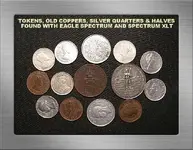DannyB1954
Full Member
- Joined
- Nov 29, 2015
- Messages
- 161
- Reaction score
- 154
- Golden Thread
- 0
- Location
- Pahrump, Nv.
- Detector(s) used
- Whites GMT, DFX, V3i. TDI SL
Fischer F-75, F-19, CZ7a Pro.
Garrett Infinium, ATX
Nokta AU Gold, Racer, Simplex, legend
Minelab Explorer SE
Tesoro Lobo ST, Tejon, Compadre
Teknetics Omega 8500
XP ORX
- Primary Interest:
- Metal Detecting
Is anyone aware of a metal detector that can hide strong signals and let the weak ones through?
I think this would be a handy feature for park hunters who are looking for the deeper older coins and jewelry, ignoring the upper level trash.
It is hard to ignore a strong signal and it is a bit distracting when listening for the soft ones.
I think this would be a handy feature for park hunters who are looking for the deeper older coins and jewelry, ignoring the upper level trash.
It is hard to ignore a strong signal and it is a bit distracting when listening for the soft ones.
Upvote
0





 Hehh. Part of what makes this hobby so challenging are the limitations that the junk imposes like it or not. Luck with that park.
Hehh. Part of what makes this hobby so challenging are the limitations that the junk imposes like it or not. Luck with that park.